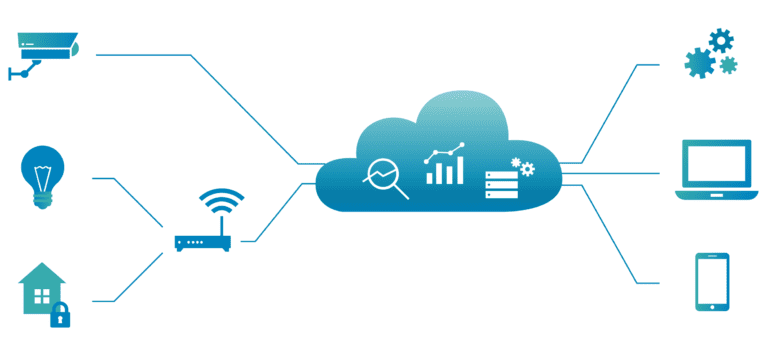Nowadays, the Swiss market is seeing an increase in efficiency, the linking of processes and data opening up new possibilities of value creation. The digital networking of people, machines and products is called “Industrie 4.0” in German-speaking countries and “Industrial Internet” in the English-speaking world.

The interconnection of things through the internet has pushed this progress. The virtual world and the real world are merging, especially in the industrial sector where it is called the “Industrial Internet of Things” (IIoT).
This progress creates profound possibilities and changes wherein everything becomes “Smart”: smart devices (PCs, cellphones, tablets), online banking and payments, online desks, intelligent buildings and even Smart Cities influence our everyday life. New needs and requirements based on IoT are a huge market for customers, providers of hardware and software, telecommunications and service providers.
In particular, it’s created a brand new market for cloud platform providers. The Internet of Things as well as cloud computing are based on similar principles and have key requirements on distributed systems and device management.
The Internet of Things may seem like a challenging field to the uninitiated: with millions of devices connecting and feeding information all at once, it would be a lot of work to track, control, manage, and yes, secure entire fleets of them. You will want to monitor your devices to ensure they are functioning correctly, update their firmware, detect and resolve errors—the works. You need a tool or service that can handle all these tasks.
AWS IoT Device Management is one of the possibilities to meet these demands. This service simplifies the process of securing, managing, monitoring, and organizing entire fleets of devices at scale. With this service, you can centrally consolidate your devices, troubleshoot any problems, and update firmware remotely, regardless of the kind of device or OS used.
Features
Rapid Device Registration – AWS IoT Device Management lets you add device details like name, type, year of manufacture, and certificates in bulk into the IoT registry. You may quickly assign these attributes to devices and put entire fleets to use at once.
Easy Organization – deploying updates to devices in a single area may be daunting, but AWS IoT Device Management makes it simple. It lets you arrange your devices into groups, each with their own group policies. This lets you quickly and easily bring your devices in line with any security or business requirements. You may also arrange your devices into hierarchies so that you may control how devices inherit your access policies.
Manage Devices Remotely – remotely update the firmware or software of any device in your fleets, ensuring their security and up-to-date status. You may also upload security patches and perform restarts whenever you need.
Device Search Function – If you need to look up a device for troubleshooting, it’s a simple matter to find it in your fleets. You may look up attributes or a combination thereof: device ID, type, or state.
Structure
AWS IoT Device Management works by allowing you to easily perform several functions at scale.
Firstly, the service allows you to quickly onboard, manage and monitor your connected devices.
Secondly, it connects with AWS IoT Core to both the AWS cloud and other devices, allowing you to see and manage your fleet devices.
Thirdly, you can audit and get alerts on the health of your devices using AWS IoT Device Defender. You may then use Device Management to send software patches or apply the solutions you want.
Finally, if you have AWS IoT Greengrass or FreeRTOS devices, you may also send them software or firmware updates over-the-air.
Practical Applications
You can use AWS IoT Device Management in a variety of ways.
For instance, you may use it to rapidly onboard and connect to fleets of devices from industrial locations. You may then gather information (such as usage and performance data) across various sectors, including technology, manufacturing, and energy. Using service alerts, you can keep track of metadata and changes to device policies so you are aware when configurations are altered. AWS IoT Device Defender will inform you of threats to the health of your devices so you may apply fixes immediately.
You can use it to determine when and how quickly to push OTA updates to a variety of consumer devices, such as smart bulbs, cameras, and security systems. You can rapidly send software updates, and patches when necessary, or automate the process to send updates the moment the device goes online.
Finally, you can apply IoT Device management for business purposes. Use it to organize your device fleets according to function, type, or any hierarchical grouping you need for your business. You can group cameras by room, for example, or according to floors or buildings. You can look at and take action on multiple devices at once with fleet indexing. You can also provision your devices in bulk so they can be quickly deployed to your sites.
Learn more about AWS IoT Device Management on our website here and at AWS here. If you wish to start applying to your business, please contact copebit today.
Orlando is CEO and founder of copebit AG. His knowledge focuses on: project management, digitalization, agile methods such as SAFe, Scrum and a holistic view of cloud technologies. He has worked in the IT industry for providers and financial service providers for over 25 years.
For the past 12 years, he has led and built multicultural teams with whom he also developed and operated various cloud platforms.
